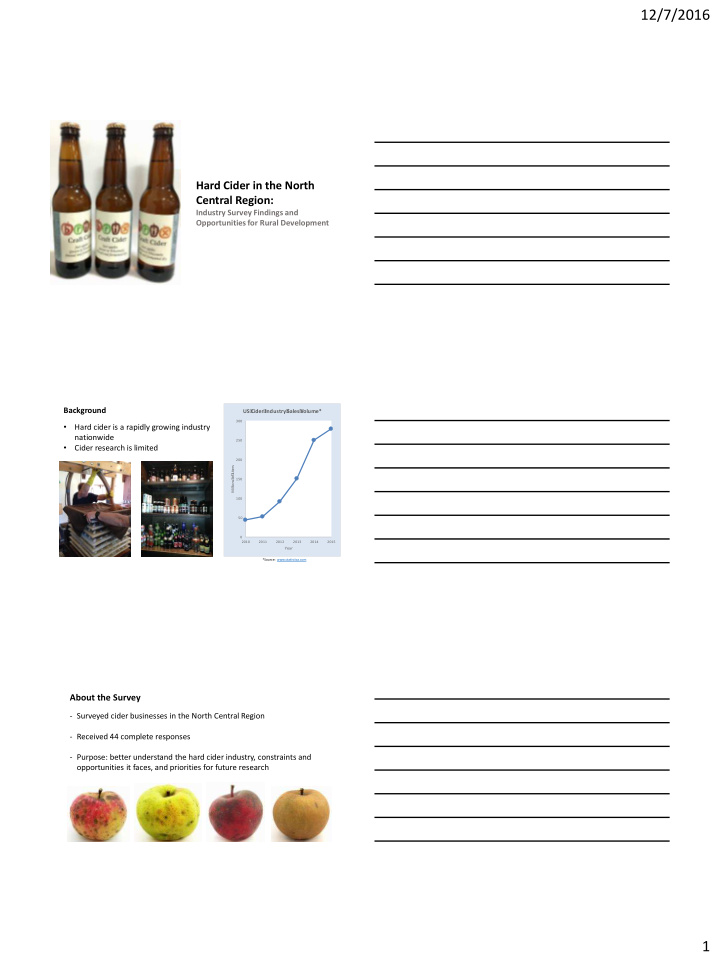



12/7/2016 Hard Cider in the North Central Region: Industry Survey Findings and Opportunities for Rural Development Background US� Cider� Industry� Sales� Volume* 300 • Hard cider is a rapidly growing industry nationwide 250 • Cider research is limited 200 Liters of� Millions� 150 100 50 0 2010 2011 2012 2013 2014 2015 Year *Source: www.statistica.com About the Survey - Surveyed cider businesses in the North Central Region - Received 44 complete responses - Purpose: better understand the hard cider industry, constraints and opportunities it faces, and priorities for future research 1
12/7/2016 Survey Results: Employees (Average of All Cideries) Full time = 1.4 1. Cidery Profiles Part time = 1.7 • The typical cidery is a small, startup Seasonal = 1.0 company First� Year� of� Cider� Production Cidery� Size Production 40 (Percent� of� Cideries� by� size� category,� based� on� 2015� sales) 35 Cideries�Starting� 30 25 20 Under�$100,000 $100,000� - $499,999� of� 15 Number� $500,000+ 10 5 0 1990-1999 2000-2009 2010-2016 Year 2. Industry Growth • Production increased more than six-fold between 2013 and 2016 • Companies project continued growth for the near future • 74 percent of respondents either agreed or strongly agreed that there is still substantial room for growth in the cider industry Cider maker quote: ”I don’t see a whole lot of bottlenecks.” 3. Profitability Cidery� Profitability • Less cideries are “in the red” than 25 ”in the black” • Many are “breaking even” 20 Respondents • Considering that many of the cideries are still startup companies, 15 this is promising Number�of� Cider Maker Quote: 10 “I put that we are ‘breaking even’ as a cidery. This is only because we have 5 had to invest a lot of money into equipment these first 2 years. We 0 should start seeing more profit this Losing� a� lot� of� Losing� money Breaking� even Profitable Very� profitable year.” money 2
12/7/2016 4. Sourcing and Processing Apples Sourcing� Apples,� Juice,� or� Concentrate • Cider maker survey respondents support local orchards • In comparison, the nation’s largest cider 0% Own� Orchard producer, Angry Orchard, purchases 9% primarily apple juice concentrate from 15% Local� Orchards� (within� non-US orchards 1 state� or� within�100� miles) 21% Juice� Processing� Approaches Regional� Orchards�(from� nearby� or� neighboring� 35 states,� less� than� 500� miles) 30 Respondents Other� US� Orchards� 25 (greater� than� 500� miles� 20 away) 55% Number�of� 15 Non-US� Orchards 10 5 0 Press� apples Have� apples� Purchase� juice Purchase� custom� pressed concentrate 1. The Boston Beer Company. 2015 Annual Report. Importance� of� Factors� in� Determining� which� Fruit� to� Buy (Averages� of� all� Cider� Maker� Ratings) Price Ease� of� negotiations,� purchase,� and� transactions Availability� of� preferred� apple� varieties Location� or� source� of� the� apples The� “ story ” � of� the� apples� (varietal� origins,� history,� etc) The� “ story ” � of� the� orchard� where� the� apples� were� grown� (people,� landscape,� … Cosmetic� appearance� of� the� fruit� (e.g.� fruit� scarring� or� blemishes) The� way� the� apples� were� grown� (e.g.management�practices� that� enhance� cider� … Use� of� environmentally� sustainable� practices� at� the� orchard� where� the� fruit� was� … Personal� relationships� with� growers Year� round� availability Source� traceability� for� compliance� or� claims� verification Not� at� all� important� � � � � � � � � � � � � � � � � � � A� little� important� � � � � � � � � � � � � � � � � � � � � � Moderately� Important� � � � � � � � � � � � � � � � � � � � Very� Important Prices Paid for Apples Cider Maker Quotes on biggest challenges in sourcing apples, juice or concentrate : “convincing local farmers to grow more cider apples and less dessert apples.” “Huge demand for good cider apples, very little supply.” “Competition for the varieties we need to make quality cider.” “They [cider apples] are WAY too expensive and way over rated IMHO for a common cider made to sell to a larger base.” “Orchards can sell their juice at farmers markets for way more than we can pay for cider so getting heirloom and cider apples is very hard, very expensive and almost not worth it.” 3
12/7/2016 Cider� Packaging� Choices 5. Cider Packaging Kegs/Draft 750� ml� (wine� or� champagne)� bottles 500� ml� bottles • Cider makers employ a broad 375� ml� bottles range of packaging options 22� oz� bottles� ( “ bombers ” ) • Cider makers are from from 12� oz� (beer)� bottles� – 6� pack 12� oz� (beer)� bottles� – 4� pack consensus on whether to market 12� oz� cans their products more like beer or 16� oz� cans more like wine Other 0 10 20 30 40 Number�of� Companies�Using� Each� Type� of� Packaging Cider� Maker� Responses� to: Do� you� market� your� cider� more� like� beer� or� wine? 0 10 20 30 40 50 60 70 80 90 100 More� like� Beer� � � � � � � � � � � � � � � � � � � � � � � � � � � � � � � � � � Somewhere� in� Between�� � � � � � � � � � � � � � � � � � � � � � � � � � � � � More� like� wine 6. Cider Sales Percent� of� Ciders� Sold� by� Location • Over 90 percent of cider is sold locally, 1% 6% with the largest proportion sold on site Locally Percent� of� Cider� Sold�by� Channel Regionally Nationally Sold� through� a� Distributor Internationally�(none) Self� Distribution Sold� on� Site 93% 0 5 10 15 20 25 30 35 40 45 4
Recommend
More recommend